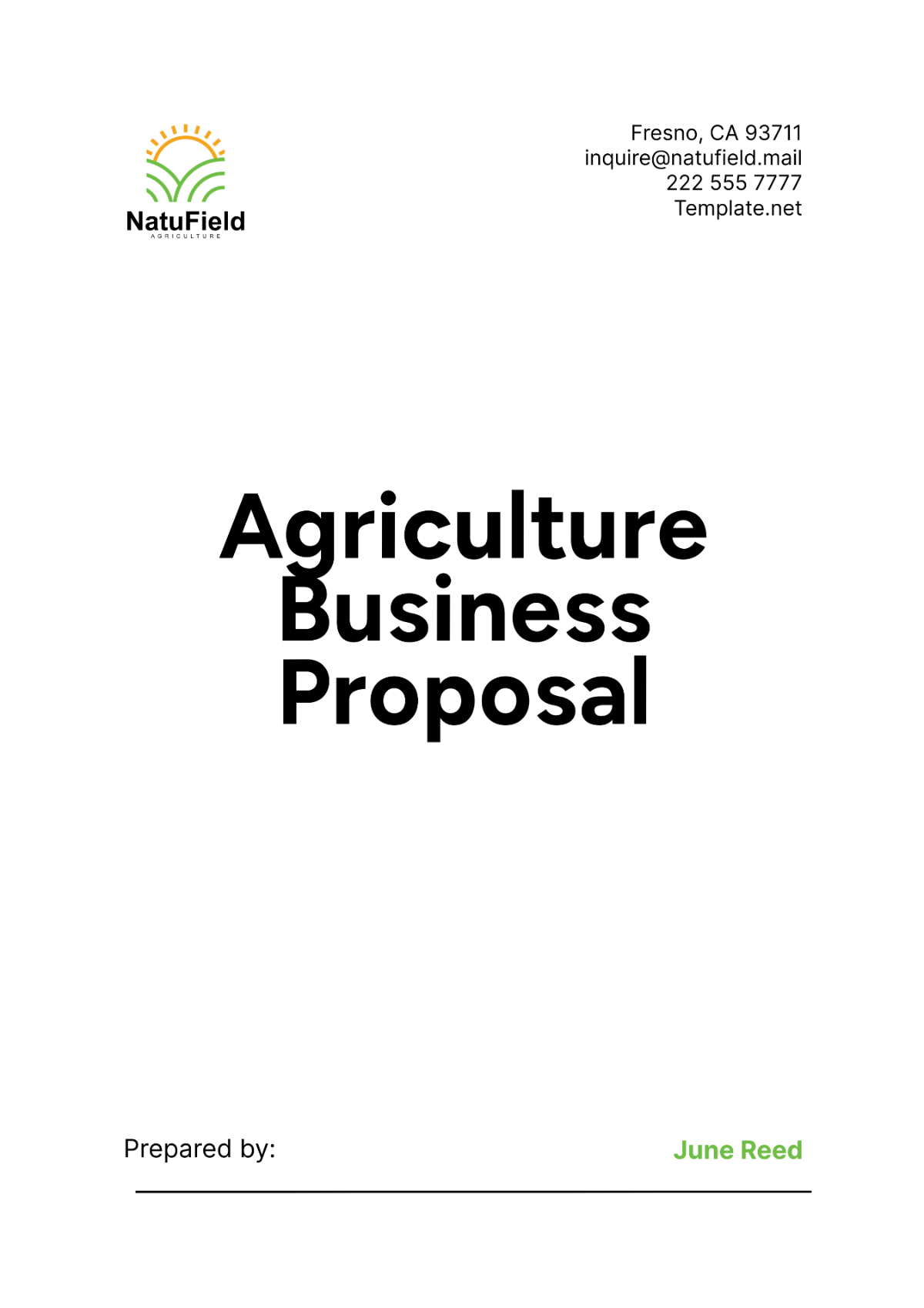Free Agriculture Business Proposal

I. Executive Summary
This Agriculture Business Proposal of [Your Company Name] outlines a comprehensive plan to expand and enhance our agricultural operations. This proposal details the strategic initiatives we aim to implement over the next five years, focusing on sustainable practices, technological advancements, and market expansion. Our objective is to increase productivity, profitability, and environmental sustainability.
Key details include a total budget of $5,000,000 to be allocated across various projects, with a projected timeline of five years. This proposal addresses the need for advanced irrigation systems, soil health improvement, and the introduction of precision agriculture technologies. By leveraging these initiatives, we aim to achieve a 20% increase in crop yield and a 15% reduction in operational costs.
This proposal emphasizes collaboration with stakeholders, including local communities, government agencies, and industry partners. By fostering strong partnerships and adhering to best practices in agriculture, we are confident that [Your Company Name] will continue to be a leader in the agricultural sector, contributing to food security and sustainable development.
II. Business Objectives
The following table outlines our primary business objectives, their expected outcomes, and the key performance indicators (KPIs) we will use to measure success. These objectives are designed to align with our strategic vision and ensure sustainable growth.
No. | Objective | Expected Outcome | KPIs |
|---|---|---|---|
1 | Increase Crop Yield | 20% increase in yield over five years | Annual yield data, harvest reports |
2 | Reduce Operational Costs | 15% reduction in costs over five years | Financial statements, cost analysis reports |
3 | Implement Sustainable Practices | Improved soil health, reduced water usage | Soil health reports, water usage records |
4 | Expand Market Reach | Entry into three new markets | Market analysis, sales reports |
A. Increase Crop Yield
Expected Outcome: Achieving a 20% increase in crop yield over the next five years will significantly boost our production capacity. This will be facilitated by adopting advanced farming techniques and technologies.
KPIs: We will track annual yield data and harvest reports to measure progress. Regular assessments will help ensure we are on target to meet this objective.
B. Reduce Operational Costs
Expected Outcome: Reducing operational costs by 15% over the next five years will enhance our profitability. This reduction will be achieved through efficient resource management and cost-saving technologies.
KPIs: Financial statements and cost analysis reports will be used to monitor cost reductions. Regular financial reviews will help identify areas for further savings.
C. Implement Sustainable Practices
Expected Outcome: Improving soil health and reducing water usage are critical for long-term sustainability. These practices will contribute to environmental conservation and resource efficiency.
KPIs: Soil health reports and water usage records will provide insights into the effectiveness of our sustainable practices. Ongoing monitoring will ensure continuous improvement.
D. Expand Market Reach
Expected Outcome: Expanding into three new markets over the next five years will increase our customer base and revenue streams. This expansion will be supported by targeted marketing and distribution strategies.
KPIs: Market analysis and sales reports will be used to measure market expansion. Regular reviews will help assess the success of our market entry strategies.
The strategic focus on increasing crop yield aligns with market demands for higher production efficiency and sustainability. By implementing advanced irrigation systems and precision agriculture technologies, we aim to optimize resource utilization and mitigate environmental impact. Reducing operational costs through efficient management practices will not only improve financial performance but also support our commitment to sustainable agriculture. Moreover, expanding into new markets presents significant growth opportunities, allowing us to diversify revenue sources and strengthen market presence.
III. Market Analysis
The following table provides an analysis of the current market landscape, including key trends, opportunities, and challenges. Understanding these factors is essential for developing effective strategies to achieve our business objectives.
No. | Factor | Description | Impact |
|---|---|---|---|
1 | Market Trends | Growing demand for organic produce | Positive impact on sales and profitability |
2 | Competitive Landscape | Presence of established competitors | Challenges in market entry and differentiation |
3 | Regulatory Environment | Stricter regulations on pesticide use | Need for compliance and alternative solutions |
4 | Technological Advancements | Increased use of precision agriculture | Opportunities for efficiency and yield improvement |
A. Market Trends
Description: The growing demand for organic produce presents a significant opportunity for [Your Company Name]. Consumers are increasingly prioritizing health and sustainability, driving the market for organic products.
Impact: This trend positively impacts our sales and profitability, as we can command premium prices for organic produce. Leveraging this demand will be key to our market expansion strategy.
B. Competitive Landscape
Description: The presence of established competitors in the market poses challenges for new entrants. Differentiating our products and services will be crucial to gaining market share.
Impact: We must develop unique selling propositions and innovative marketing strategies to stand out. Investing in quality and customer service will help us build a loyal customer base.
C. Regulatory Environment
Description: Stricter regulations on pesticide use are being implemented globally. Compliance with these regulations is essential to avoid penalties and maintain market access.
Impact: Adopting alternative pest control methods and sustainable practices will be necessary. Investing in research and development will help us stay ahead of regulatory changes.
D. Technological Advancements
Description: The increased use of precision agriculture technologies offers opportunities for efficiency and yield improvement. Technologies such as drones, sensors, and data analytics can revolutionize farming practices.
Impact: Integrating these technologies into our operations will enhance productivity and reduce costs. Continuous investment in technology will be a key driver of our success.
Analyzing current market trends highlights the significant opportunity in organic produce, driven by consumer preferences for healthier and sustainable food choices. While the competitive landscape poses challenges, our focus on quality and innovation will differentiate us from competitors. Adapting to stricter regulatory environments through sustainable practices and technology adoption will ensure compliance and operational efficiency. Embracing technological advancements like precision agriculture will not only improve yield but also position us as leaders in agricultural innovation.
IV. Financial Plan
The following table provides a detailed financial plan, including projected expenses, revenues, and profitability over the next five years. This financial plan supports our strategic initiatives and ensures sustainable financial growth.
Item | 2051 | 2052 | 2053 | 2054 | 2055 | Total |
|---|---|---|---|---|---|---|
Advanced Irrigation Systems | $1,000,000 | $500,000 | $0 | $0 | $0 | $1,500,000 |
Precision Agriculture Technology | $0 | $750,000 | $500,000 | $0 | $0 | $1,250,000 |
Organic Product Development | $500,000 | $500,000 | $500,000 | $0 | $0 | $1,500,000 |
Market Expansion | $0 | $0 | $500,000 | $750,000 | $500,000 | $1,750,000 |
Total Expenses | $1,500,000 | $1,750,000 | $1,500,000 | $750,000 | $500,000 | $6,000,000 |
A. Projected Expenses
2051: The primary expenses in the first year will be the implementation of advanced irrigation systems ($1,000,000) and initial development of the organic product line ($500,000). These investments will lay the foundation for increased productivity and market differentiation.
2052: In the second year, significant expenses will include the introduction of precision agriculture technology ($750,000) and continued development of the organic product line ($500,000). These investments will enhance operational efficiency and support sustainable growth.
B. Projected Revenues
2053: Revenue growth will begin to accelerate as the new initiatives start to yield results. Market expansion efforts ($500,000) will also commence, targeting entry into new markets.
2054: Continued market expansion ($750,000) will drive further revenue growth. The impact of precision agriculture technology and organic product development will become more pronounced, increasing overall profitability.
C. Projected Profitability
2055: By the fifth year, the combined impact of all strategic initiatives will lead to significant profitability. Continued market expansion ($500,000) and sustained benefits from earlier investments will ensure long-term financial success.
Overall Financial Outlook: The total projected expenses over five years amount to $6,000,000. However, the expected increase in crop yield, market expansion, and operational efficiency will result in substantial revenue growth and profitability.
The financial plan outlines our commitment to strategic investments in infrastructure, technology, and market expansion to drive revenue growth and profitability. While initial expenses are significant, these investments are essential for enhancing operational efficiency and competitiveness. Projected revenues reflect our optimistic outlook on market demand and growth potential. Continuous financial monitoring and adjustment of strategies will ensure we stay on track to achieve our financial objectives.
V. Risk Management
The following table outlines the key risks associated with our business plan, their potential impact, and the mitigation strategies we will implement. Effective risk management is essential for the successful execution of our strategic initiatives.
No. | Risk | Potential Impact | Mitigation Strategy |
|---|---|---|---|
1 | Market Fluctuations | Revenue loss, market share decline | Diversify markets, flexible pricing strategies |
2 | Regulatory Changes | Compliance costs, operational disruptions | Monitor regulations, proactive adaptation |
3 | Technological Failures | Operational inefficiency, cost overruns | Invest in reliable technology, staff training |
4 | Environmental Factors | Crop loss, supply chain disruptions | Implement sustainable practices, insurance |
A. Market Fluctuations
Potential Impact: Market fluctuations can lead to revenue loss and a decline in market share. Volatile prices for agricultural products can affect profitability and financial stability.
Mitigation Strategy: Diversifying markets and implementing flexible pricing strategies will help mitigate the impact of market fluctuations. Continuous market analysis will enable proactive adjustments to our strategies.
B. Regulatory Changes
Potential Impact: Regulatory changes can result in compliance costs and operational disruptions. New regulations may require significant adjustments to our practices and processes.
Mitigation Strategy: Monitoring regulatory developments and adopting a proactive approach to compliance will minimize the impact of regulatory changes. Investing in alternative solutions and technologies will ensure compliance with minimal disruption.
C. Technological Failures
Potential Impact: Technological failures can lead to operational inefficiency and cost overruns. Dependence on technology for critical operations increases the risk of disruptions.
Mitigation Strategy: Investing in reliable technology and comprehensive staff training will reduce the risk of technological failures. Regular maintenance and updates will ensure the smooth operation of technological systems.
D. Environmental Factors
Potential Impact: Environmental factors such as extreme weather events and climate change can cause crop loss and supply chain disruptions. These factors pose significant risks to agricultural operations.
Mitigation Strategy: Implementing sustainable practices and securing insurance coverage will help mitigate the impact of environmental factors. Diversifying crop types and improving infrastructure resilience will also enhance our preparedness.
Effective risk management is crucial for the successful execution of our business plan. Market fluctuations and regulatory changes are primary concerns that require proactive strategies such as diversification and compliance monitoring. Technological failures and environmental factors also pose operational risks that necessitate investments in resilience and contingency planning. By addressing these risks comprehensively, we aim to minimize disruptions and ensure the continuity of our operations and growth initiatives.
VI. Implementation Plan
The following table outlines the implementation plan for our strategic initiatives, including key milestones, timelines, and responsible teams. This plan ensures the effective execution of our business objectives.
No. | Milestone | Timeline | Responsible Team |
|---|---|---|---|
1 | Complete Irrigation System Setup | 2051 | Operations Team |
2 | Launch Precision Agriculture | 2052 | Technology Team |
3 | Release Organic Product Line | 2053 | Product Development Team |
4 | Achieve Market Expansion | 2054 - 2055 | Marketing and Sales Team |
A. Complete Irrigation System Setup
Timeline and Team: The setup of advanced irrigation systems will be completed in 2051 by the Operations Team. This milestone is critical for enhancing water efficiency and crop health.
Objectives and Benefits: The main objective is to reduce water usage by 20%, contributing to cost savings and sustainability. This setup will also support higher crop yields and improved productivity.
B. Launch Precision Agriculture
Timeline and Team: Precision agriculture technologies will be launched in the 2052 by the Technology Team. These technologies will optimize farming practices and increase productivity.
Objectives and Benefits: The primary objective is to increase crop yield by 15% and reduce input costs by 10%. The use of data analytics will enable informed decision-making and resource management.
C. Release Organic Product Line
Timeline and Team: The organic product line will be released in the 2053 by the Product Development Team. This initiative addresses the growing demand for organic produce.
Objectives and Benefits: Launching organic products will enhance market differentiation and profitability. Achieving organic certification will open new market opportunities and attract health-conscious consumers.
D. Achieve Market Expansion
Timeline and Team: Market expansion efforts will be focused on years 2054 and 2055, driven by the Marketing and Sales Team. Targeting new markets will diversify revenue streams and increase sales.
Objectives and Benefits: Entering three new markets will boost overall sales by 25%. Strategic marketing campaigns and partnerships will facilitate successful market entry and growth.
Our implementation plan emphasizes the implementation of advanced irrigation and precision agriculture technologies to optimize resource utilization and improve crop yields. These initiatives are crucial for achieving sustainable growth and operational efficiency. Developing an organic product line aligns with market trends towards healthier food choices, providing a competitive edge in the market. Furthermore, expanding into new markets presents significant growth opportunities, allowing us to capitalize on untapped customer segments and increase market share.
VII. Conclusion
This Agriculture Business Proposal of [Your Company Name] outlines a strategic plan to enhance our agricultural operations through sustainable practices, technological advancements, and market expansion. With a strategic budget and timeline, we aim to increase crop yield, reduce operational costs, and enter new markets.
Our commitment to sustainability, innovation, and stakeholder engagement will drive our success and contribute to the broader goal of food security and environmental conservation. By implementing advanced irrigation systems, precision agriculture technologies, and organic product lines, we will achieve significant productivity and profitability improvements. We are confident that this proposal will position [Your Company Name] as a leader in the agricultural sector while ensuring long-term growth.
- 100% Customizable, free editor
- Access 1 Million+ Templates, photo’s & graphics
- Download or share as a template
- Click and replace photos, graphics, text, backgrounds
- Resize, crop, AI write & more
- Access advanced editor
Write winning proposals with our Agriculture Business Proposal Template from Template.net! This fully editable template allows you to customize the content to your specific business needs. Customizable sections enable seamless branding integration. The AI Editor Tool streamlines the process, ensuring a detailed and professional proposal tailored to your business goals!
You may also like
- Business Proposal
- Research Proposal
- Proposal Request
- Project Proposal
- Grant Proposal
- Photography Proposal
- Job Proposal
- Budget Proposal
- Marketing Proposal
- Branding Proposal
- Advertising Proposal
- Sales Proposal
- Startup Proposal
- Event Proposal
- Creative Proposal
- Restaurant Proposal
- Blank Proposal
- One Page Proposal
- Proposal Report
- IT Proposal
- Non Profit Proposal
- Training Proposal
- Construction Proposal
- School Proposal
- Cleaning Proposal
- Contract Proposal
- HR Proposal
- Travel Agency Proposal
- Small Business Proposal
- Investment Proposal
- Bid Proposal
- Retail Business Proposal
- Sponsorship Proposal
- Academic Proposal
- Partnership Proposal
- Work Proposal
- Agency Proposal
- University Proposal
- Accounting Proposal
- Real Estate Proposal
- Hotel Proposal
- Product Proposal
- Advertising Agency Proposal
- Development Proposal
- Loan Proposal
- Website Proposal
- Nursing Home Proposal
- Financial Proposal
- Salon Proposal
- Freelancer Proposal
- Funding Proposal
- Work from Home Proposal
- Company Proposal
- Consulting Proposal
- Educational Proposal
- Construction Bid Proposal
- Interior Design Proposal
- New Product Proposal
- Sports Proposal
- Corporate Proposal
- Food Proposal
- Property Proposal
- Maintenance Proposal
- Purchase Proposal
- Rental Proposal
- Recruitment Proposal
- Social Media Proposal
- Travel Proposal
- Trip Proposal
- Software Proposal
- Conference Proposal
- Graphic Design Proposal
- Law Firm Proposal
- Medical Proposal
- Music Proposal
- Pricing Proposal
- SEO Proposal
- Strategy Proposal
- Technical Proposal
- Coaching Proposal
- Ecommerce Proposal
- Fundraising Proposal
- Landscaping Proposal
- Charity Proposal
- Contractor Proposal
- Exhibition Proposal
- Art Proposal
- Mobile Proposal
- Equipment Proposal
- Student Proposal
- Engineering Proposal
- Business Proposal





























